Text
Studio VI - Index
Kimi Slides:
https://docs.google.com/presentation/d/1dYR8kVgnXwYdgTWfzKyxs74PEn4bITFqV5tDDw_Q1Lo/edit?usp=sharing
Kimi - Progress Slides:
https://docs.google.com/presentation/d/1bK6PNEL6-MpI0U-wby_0AjaLLR2ZrEagj4Rd9jqMsp8/edit?usp=sharing
https://docs.google.com/presentation/d/1ISijtTWdgmNZl1BxLoOwLL1l6XQlONfL5J_deDUDUx0/edit?usp=sharing
4 notes
·
View notes
Text
Interaction & Play Index
Week 1:
https://vaanibct.tumblr.com/post/186435437621/interaction-play
Week 2:
https://vaanibct.tumblr.com/post/186811788296/interaction-play
Week 3:
https://vaanibct.tumblr.com/post/186812190206/interaction-play
Week 4:
https://vaanibct.tumblr.com/post/186902411546/interaction-play
https://vaanibct.tumblr.com/post/186902426886/interaction-play
Week 5:
https://vaanibct.tumblr.com/post/188443728506/interaction-play
https://vaanibct.tumblr.com/post/188443917836/interaction-play
Week 6:
https://vaanibct.tumblr.com/post/188443928576/interaction-play
https://vaanibct.tumblr.com/post/188443932991/interaction-play
Week 7:
https://vaanibct.tumblr.com/post/188443960561/interaction-play
https://vaanibct.tumblr.com/post/188443976646/interaction-play
Mid-Sem Break:
https://vaanibct.tumblr.com/post/188443990081/interaction-play
https://vaanibct.tumblr.com/post/188444001141/interaction-play
Week 8:
https://vaanibct.tumblr.com/post/188444008591/interaction-play
https://vaanibct.tumblr.com/post/188444011621/interaction-play
Week 9:
https://vaanibct.tumblr.com/post/188444026821/interaction-play
https://vaanibct.tumblr.com/post/188444033771/interaction-play
Week 10:
https://vaanibct.tumblr.com/post/188444108811/interaction-play
https://vaanibct.tumblr.com/post/188444112166/interaction-play
Wiser - Presentation Slides:
https://docs.google.com/presentation/d/1OslPwJysci7kltnolerA5stSqL_Ayx1AFvcQE-lp_hs/edit#slide=id.g5d31ec324e_1_5
———————————————————————————————————————————
1 note
·
View note
Text
Interaction & Play
Teamwork Thursday (03-10-19)
Today was our last ‘Discovery Session.’ It was held in the Wiser Space again, but this time, we set up in a different pod to change a bit of the environment. This group was also a bit on the older side because they were the staff at University. Since the Decision-Making Workshop was open to everyone, not just the students, we had to make sure that our activity would be relevant to all ages. Rebecca had organised the playtesters for today’s session, but was unable to join us, so Anja (another member of the Wiser team) subbed in to take notes and observe.
This was a very different session, to be honest. It was interesting to see how adults (supposedly aged 30-45) react to the questions and the overall play elements of the activity compared to the younger students. This was also a group four - three men and a women - and weirdly, two of the decisions were based on ‘gardening.’ Another weird fact was that one of the decisions was not the person’s own past decision yet they still chose to discuss it.


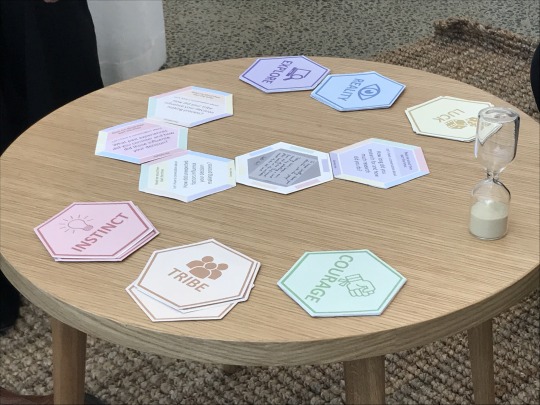

Playtest Feedback and Observations:
We noticed that the cards were a little small compared to one of the male participant’s hands. This was not a huge issue, but just a minor observation.
This group was very serious and focused n the rules, as well as the timer. They only turned the timer when they had read out the question and thought about what they would say. They were also keeping a close eye on the end of the time, and based the length of their conversation on that. It seemed as if they were really concentrating on the rules as they didn’t want to it “wrong.”
The participants were passing the cards around to each other after saying their side of the story. This was good to see as we did intend the cards to be passed around (there’s no rule saying they have to stay on the table once drawn.)
The tile placement mechanic for this group was a little different as well - they decided to form a ‘snake.’ Using as they cards say “connect me” to the last card, the intended outcome would somewhat seem like a trail, however they deliberately chose Influences that were at the top of the previous card. This tactic soon ended when they started their second turn, as the spaces to place the certain cards were limited. At they end, they were a little sad that there wasn’t any meaning to the final “design” of the cards on the table - there wasn’t a conclusion to what the cards connected together meant for their discussion.
The play mechanics seemed to have stretched the discussion. Overall, this group’s discussion was quite deep and adult-like. They did go off topic quite a few times and started their own side - stories, but they also said meaningful things about decisions and life, which was interesting to hear as an observer. However, they also said that the “element of surprise” was missing.
One of the feedbacks we received was quite strange for me, as it was unusual to what we have been hearing. One of the participant’s said - “I liked it until I found out there was no point to it. It doesn’t seem to have a purpose.” This statement was basically the opposite of what we were hoping for, and what the idea of the activity was.
“Overall, I liked it. It’s very creative. Good way to get us engaged.”
“The structure was good. Really poked at the right angles of the your decision.”
“I liked the piles of the factors in colours.”

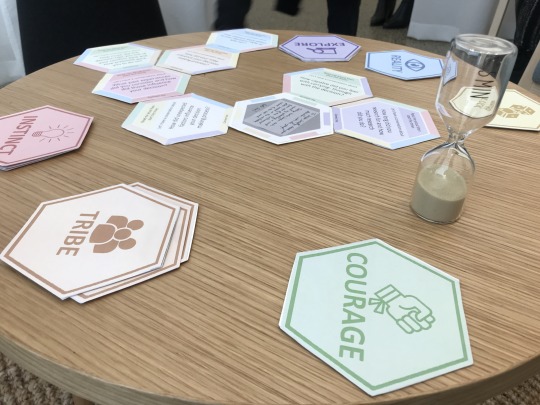
Here is the overall debrief of all the ‘Discovery Sessions’ and our learnings:
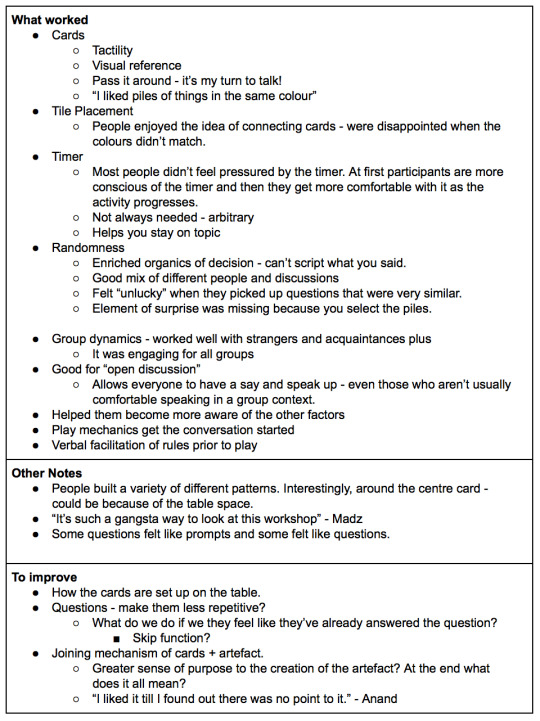
Next week, Carol, Talia and I will start writing our final A4 Project Description for Submission. This is due in two weeks time. So, from here on, no improvements and playtesting will be done to the activity, as we have to focus on the assessment requirements. We have advised the Wiser team about our assessment, so we will be in touch with them later on, most probably after the exams period.
As this is my last Blog post for Interaction and Play, I’d like to reflect on the paper and the project. This has been one of my favourite paper and group project in my time at Creative Technologies. I have really enjoyed learning about play and game design methodologies, as well as team ethics. Our progress and development over the Semester has affected my way of thinking and working, which I know is beneficial for my future. Working for a real “client” has also proved advantageous as we have a better idea of how to communicate and interact with them, as well as conduct user experience testing with potential users. Overall, I’m very happy and proud of our team’s effort and progress with this project. We have achieved so much and I am glad to be a part of it.
———————————————————————————————————————————
1 note
·
View note
Text
Interaction & Play
Day 10 (30-09-19)
Today in class, we discussed the final A4 document submission. Ben gave us some notes about writing the concept and context, as well as how to fit it in one page basically. I looked through his exemplar document and realised that it was very concise, but it explained everything and referred to the research. He explained that we can write the hand-in as a group, but will have to submit ours individually and properly reference everything we wrote as a group.
We have already planned to start writing our draft report as a group next week, after finishing with the ‘Discovery Sessions’ this week. We ensured to give us extra time to get the draft checked with Ben and get feedback. I am not too worried about this because I feel we have enough information and resources to fully portray our concept and prove the contextual research behind our idea.
We also held our third ‘Discovery Session’ today. This was in the Wiser Space and consisted of all students (from AUT and Auckland Uni). However, we did have a slight change - we had a group of 5 people. This provided us an opportunity to test the activity with a slightly bigger group (because the Decision-Making Workshop group will be divided into 2, with 4-5 people in each group).
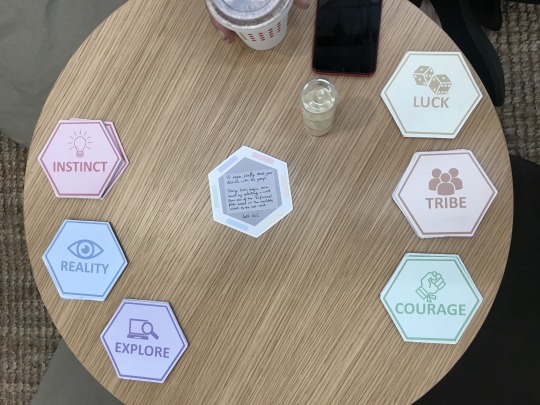

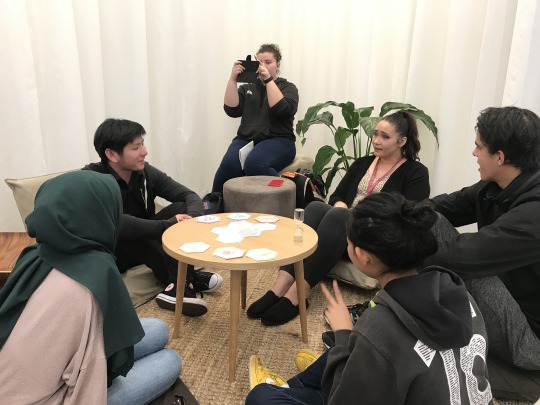
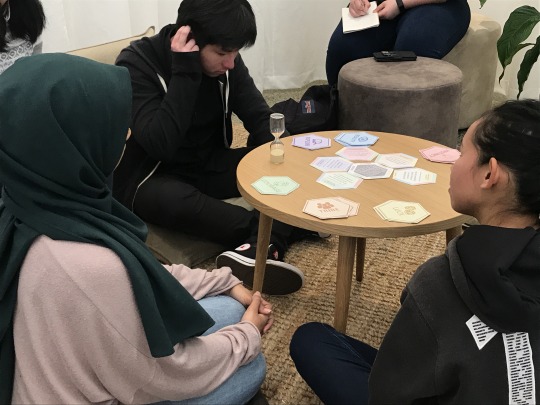
Playtest Feedback and Observations:
This group was quite focused on the timer. They based their conversation to match the timer’s end and then continued tot he next questions card. However, there were times where they went “overtime,” for which they turned the timer again. This led to the idea of a “resettable timer” - because we can’t make the sand timer go any faster, when its reset (if the discussion finishes early). In a way, they felt pressured due to the timer, and it did affect their overall discussion.
They liked the tactility of the cards - passing them around to each person for them to read the question. However, they were not connecting the card to the last one. This is because they were trying to form a “flower” design, not a snake. This affected which card they would choose next. Also, the shape of the table also affected where the participants placed the cards - since it was a round table, they were trying to create a roundish design.
In terms of the discussion, the conversation they had was quite deep and did last quite long. They were really discussing the Influences for each of their decisions and justified their process. They also said that seeing this framework will help them make future decisions, as it’ll be easier to refer to this discussion. Nonetheless, it was a well-rounded discussion overall.
The questions were okay. They said some cards felt like “prompts” to start the discussion, while others felt like real questions to answer. It was a good mixture of cards, but they were a talkative group anyways, and didn’t need set questions to discuss different parts of the Influences.
“Such a GANGSTA way to look at the Workshop!”
“The timer is really arbitrary.”

The overall playtest was pretty great. We received a lot of positive feedback from this group and it was also one of my favourites, because they carried out a good discussion flow. I think that these ‘Discovery Sessions’ are really helpful to our Project. The feedback and ratings we’re receiving are mostly constructive, and encouraging us to look for solutions to improve the play aspects.
We will probably not work on this Project after this week, as this is our last step until submission. We aim to work on the final “Interaction and Play” hand-in for the next two weeks. For this reason, we are unable to interact with Wiser and continue developing the concept. But this is not the end, as we will further work on this project during the summer / next year.
———————————————————————————————————————————
0 notes
Text
Interaction & Play
Teamwork Thursday (26-09-19)
We had planned another ‘Discovery Session’ today. As Rebecca was unable to find many people for this playtest and the WZ Wiser Space was unavailable, we decided to ask a couple of BCT Students to join and a couple of our own friends, and held the session at WG Level 11. This was quite an open space as all Students are allowed to come up to the common area and study/relax.
We took this as an opportunity to see how the ‘environment’ or the ‘space’ of the session affects the overall outcome. My hypothesis was that students would be too shy to speak loudly or openly about their decisions / actions as there were other students studying around them. Maybe the thought of opening up to discuss personal decisions in an open space was too intimidating.
I was proven quite wrong, which I’m glad about because this was a much better playtest session than our last one. Talia explained the activity to the participants and they understood the purpose of the cards. They followed the rules and I think the instructions were better understood as well.



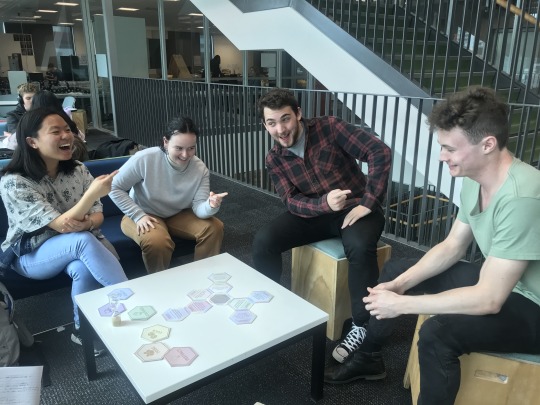
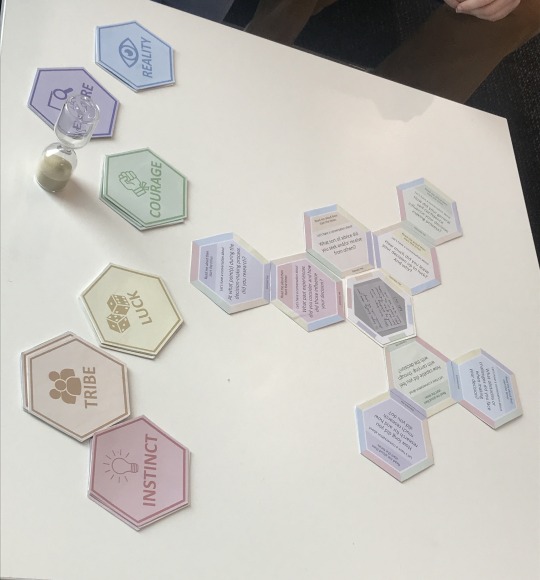
Playtest Feedback and Observations:
The participants felt that the first questions encouraged them to talk a lot, but they were also too focused on the time. For this reason, they hurried their conversation and ensured everyone in the group had time to discuss the Influence based on their decision. However, after a while, they felt more comfortable with the discussion and kind of forgot about the timer.
They were facilitating the activity quite well. They decided to go in a clockwise order in which they were sitting. This allowed them to stay focused and not lose track of “who’s turn is it next?” But this also influenced the card category they chose, because they wanted to choose a card at least once from the 6 categories. They only did this in their second turn, by when all the six categories were discussed.
The participants really liked the tile-placement aspect. They were trying to make their discussion journey into a cool “shape / pattern.” This, in a way, also impacted the Influences they choose, but they said it was easier to pick the category because they had an outcome in mind.
In terms of the game mechanics, I think this group was quite open and willing to talk. They first discussed how they wanted to “run” the game, as well as cover all the categories because it’s a part of the enjoyment tactic. The cards were a great aspect of the game because the tactility added fun to the discussion. They liked holding the physical cards.
The questions were brought up again. The participants thought they were too broad and the group went off topic a couple of times during the discussion. We may need to introduce another mechanic to control that aspect of the game, but I personally think that by having too many constraints, the discussion wouldn’t seem natural or personal. So going off topic is part of the activity. And anyways, this activity is being developed for Wiser’s Decision-Making Workshop, which will have a facilitator to guide or manage the discussion. Carol also thinks that without the prompts, the questions seem too alike. And when the group had all their chosen cards laid out by the end of the discussion, they also realised the similarities between the questions. So, we will definitely need to iterate the questions again.
One of the biggest concern for this group was that the tiles didn’t match up perfectly. This could be because most of them were design-thinking students and were annoyed that the colours were not matching up when they connected all their cards. They “NEEDED IT TO CONNECT.”
We received some feedback from the group about having a way to redraw a card or adding a “veto” rule. This way, if they have already discussed an aspect of the Influence or don’t want to talk about it, or if it doesn’t relate to their decision, then they can choose another card.
“There are lots of factors of decision-making and we need to be aware of these factors.”
“This is the best ice-breaker. It’s a great way to get to know people.”

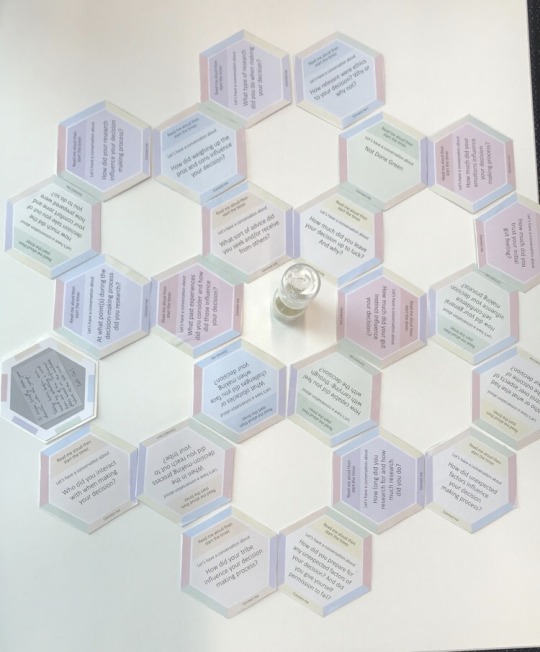
Overall, I was quite happy with the outcome of this playtest session. It made me feel better about the activity and our progress, compared to our first one. The space and environment didn’t have much impact on the discussion or the choice of decisions because the participants kept the conversation going. They may not have reflected on their decisions as much as we would have likes, but they definitely had fun talking with each other and discussing the Influences. We were told that this activity is quite versatile and may even work for other situations and ideas, not just decision-making. Honestly, we haven’t thought about that yet because our ain has been to follow the brief and create an interactive experience for the Workshop. However, I remember Ben even mentioned that this is a great project idea and has a good concept. We could definitely further work on this project after Uni, but we haven’t really discussed it much.
We will continue gathering data with two more ‘Discovery Sessions’ planned to take place next week. We are hoping that they work well and provide us with critical feedback for improvement.
———————————————————————————————————————————
0 notes
Text
Interaction & Play
Day 9 (23-09-19)
Today was our Research Report session / presentation. This allowed all the groups in the class to showcase their finalised idea and prototypes, giving other students an opportunity to look at their progress and cool, interactive and playful activities. We also had the chance to play with a couple of the “Games” by other groups and see their idea come to life, as well as provide feedback.
After class, we had already planned our first ‘Discovery Session’ with some Student Ambassadors at the Wiser Space. Rebecca said she’d join us as well, to record some notes and understand our current iteration. We were quite happy that she was joining in and had been supporting us with the progress of this project.
We went a little early to set everything up and get ourselves prepared to hold the session. The cushions / seats and coffee table were already organised by Rebecca and we set up the cards and timer on the table to ensure it was easily available by everyone.
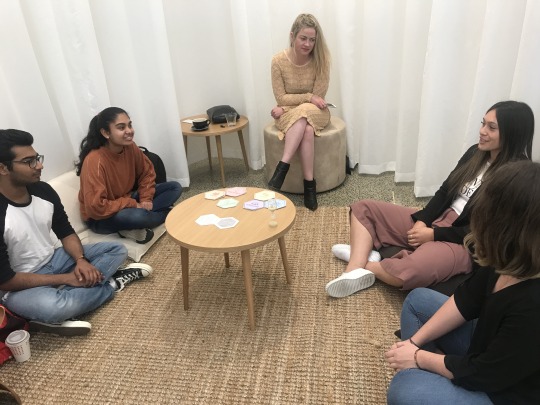
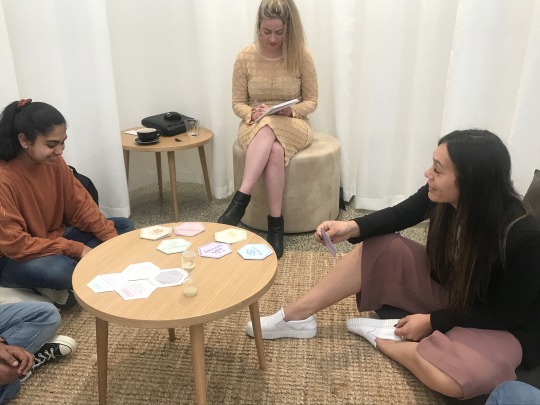
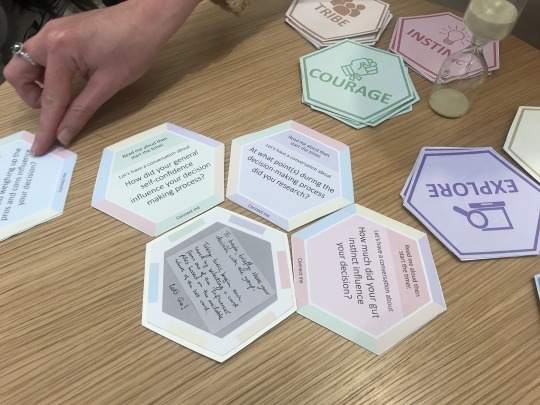

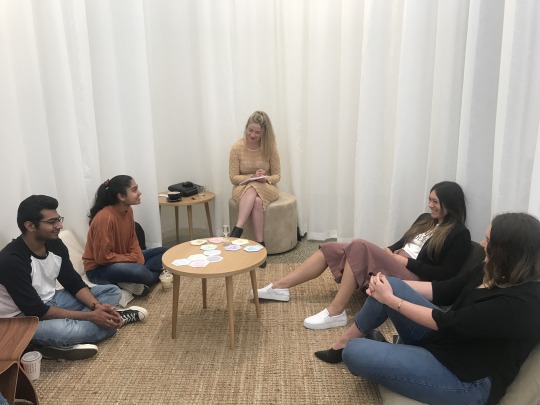

Overall, I think the Session was quite interesting. The group that joined us for this playtest was a little confused about the execution of the activity, and they weren’t too open about their decisions. Even though the conversation was running well and people were interested in other’s decisions, I think they didn’t properly understood the instructions and purpose of the cards.
Here are the debrief notes:
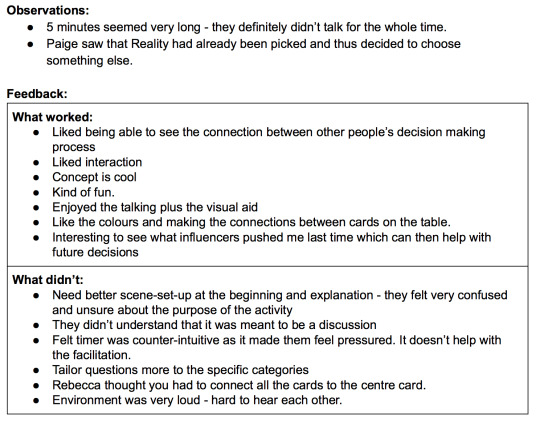
We also decided to receive quantitative data for all the ‘Discovery Sessions’ held within these two weeks, to better understand how we can improve our concept. This would also give us an idea of how people ‘rate’ the activity and it’s aspects. We realised that people can be completely honest in an anonymous survey and therefore, provide us with honest ratings, while they would be a little hesitant to say that to us directly. So, we gathered our quantitative data using this medium.
However, we still asked the participants some questions regarding the cards and instructions to get some qualitative data. This helped us with understanding the meaning behind their “ratings” and what they feel should improve.

To be honest, I didn’t feel that this session went too well in terms of the discussion aspect of the activity. Since it was our first discovery session, I think we may not have explained it quite well, but we followed the script [1]. However, we also wanted the participants to facilitate the activity, which didn’t happen successfully, also demonstrating that the questions or the instructions on the cards were not self-explanatory.
Our next session will be held on Thursday. We have decided to keep the playtest session as it is, because making any changes would create inconsistency and our findings would be inaccurate.
Reference:
[1] Facilitation Script - https://docs.google.com/document/d/1C7bvc2yCSeBvbZ1EKb6nbpkMoSDl0ldJpIfFUVnoiyw/edit
[2] Quantitative Feedback - Wiser Survey - https://forms.gle/ud2EDhTpxqvqHcVKA
———————————————————————————————————————————
0 notes
Text
Interaction & Play
Teamwork Thursday (19-09-19)
Today, we worked on our Research Report for the class presentation on Monday. For this, we had to incorporate further information to our group slides, including Concept, User Testing techniques, and the Raw Data we received through playtesting. We finished this quite quickly as we had to continue improving our cards. Having our “Final” Cards and activity prepared for this assignment, we also added in the finalised rules to our slides, to give more insight into the activity.

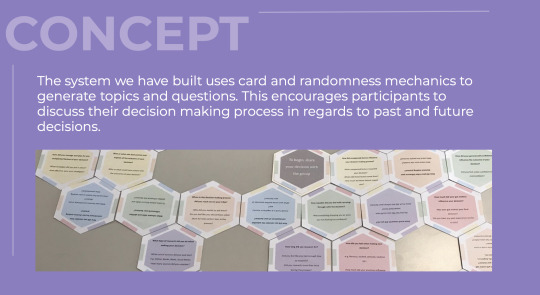

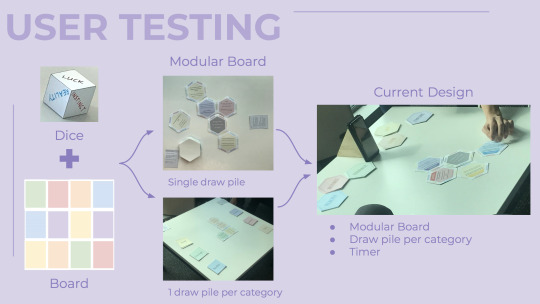

Over the last couple of days, Carol had been designing the cards in Photoshop and iterating them through our feedback. The overall design of the cards is quite important, I believe, as it attracts the players, encouraging them to participate, while the calming (pastel) colours provide a sense of trust and comfort.
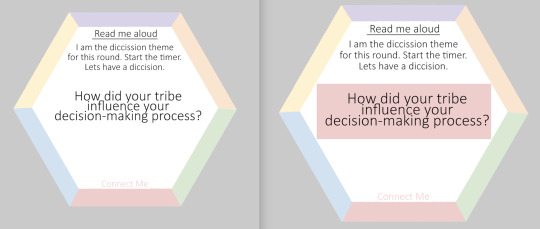
First Iteration - Testing text size and colours
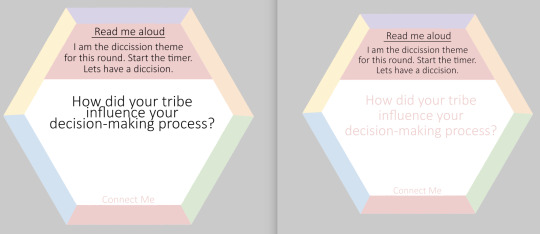
Second Iteration - Testing rule placement and text colour

Third Iteration leading to the ‘Final’ card design
Through the iteration process, we landed on the final Card design, which incorporated the rules and the discussion question / topic. We also decided to make the back of the cards appealing, but adding icons relating to the Influence. This was a bit difficult, as we were unsure of how to represent each category. There were already predetermined icons that represented each Influence and it would be difficult for the players to understand the themes otherwise. For example, a dice and a four-leaf clover are associated with ‘Luck,’ and a group of people are associated with ‘Tribe’ so we planned on using one icon to portray the Influence.
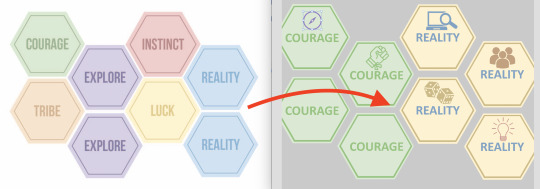
We have also come across a sad challenge, which may influence the overall activity and we have tried to find solutions for this, but unfortunately, it is almost impossible to fix the problem. During our first playtest with the ‘hexagon’ cards, Ben mentioned that there was a design flaw - the outer colours of the cards were not matching accurately. We didn’t even notice this at first, however, after many hours trying to figure out which colours to swap around and change, we didn’t get anywhere. Carol broke the news that it is actually impossible to match all the colours perfectly in a 6-sided shape. I researched online [1, 2], looking at existing cards and theories, however, it is just mathematically not possible.
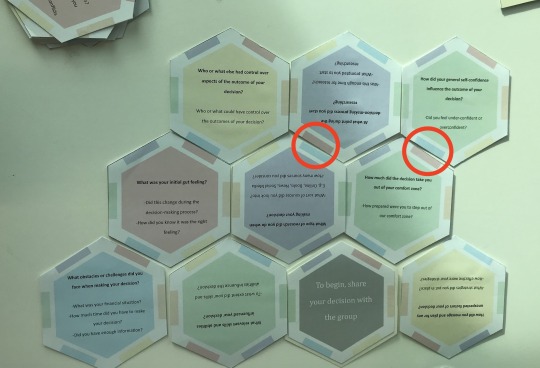
So, we have decided to keep the cards as they are. Trying to find a solution for tile-placement and journey mapping through colour-matching will be our next step, after we finish the assignment. As Ben said, this problem is too large for the scope of the paper and we are not entitled to solve it during this time. So, this is something we need to develop when we continue collaborating with Wiser to improve this activity.
Reference:
[1] https://www.flickr.com/photos/61236172@N08/7771637690?fbclid=IwAR1PLstBj9BIbFaylveUaK6oHFkRgqZy2HZAryxy_wBLjPHZNjd51zzhYcY
[2] https://www.jaapsch.net/puzzles/circus.htm?fbclid=IwAR04WsX7ZQaUMMgfBSD4i-TwX25QCZ-4MmSSZBLfm54Wc4Pp7Pp2KDgWvo8
———————————————————————————————————————————
0 notes
Text
Interaction & Play
Day 8 (16-09-19)
It felt nice to be back in class. My two-week break had been quite fun and a little relaxing. Getting back to work now felt normal. As Carol was unable to come in today, Talia and I continued to iterate the activity. Looking through our playtest feedback and plan for action, we realised that the first task was to work on the rules and then the questions [1].
So, an idea we though upon was to have the rules on the cards, but in a much simpler way. For example, instead of having what we have now, we break it down into parts and spread it across the card for the players to read the instructions easily.
Looking at precedents such as ‘Love Letter,’ [2] and ‘Fire of Eidolon’ [3], we had made a separate “Rules” card to support our activity. However, the players didn’t pay much attention to the rules and were quite confused with the objective of the activity.
So, our new idea was to incorporate the rules as part of the “Question Card,” making it quicker for the player to react to the rule. This was inspired by a card game that Ben introduced to our group, ‘Initiate.Collaborate’ [4], where the instructions are written at the bottom of the card, prompting the user to take that action. We tested this theory in class today, and surprisingly, it was better understood by the students. This positive feedback encouraged us to finalise our “rules” after a few iterations.
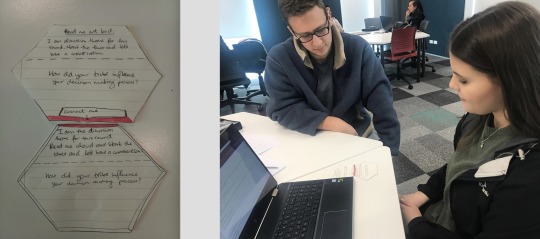
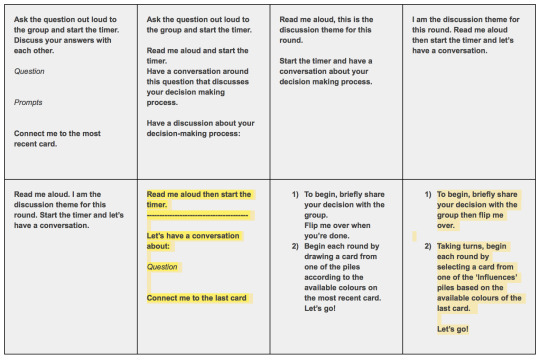
Then we worked on the Questions for each Influence. As suggested by many of our playtesters, we need to base the questions more around the factor, as they were a little broad but also quite focused on one aspect. So, we thought about making them more reflective. This led to us having only four cards per category, instead of six cards. It turned out to be quite difficult to work on the questions as we wanted to cover as many aspects of each category, however they all had to be broad enough to be understood easily by the players.
We also decided to remove the prompts for each question as they were taking up quite a bit of space on the card. Instead, we now had our rules and just the one question per card. This was actually interpreted to be the ‘topic of discussion,’ so the participants didn’t feel the pressure of “answering” the question correctly. I think this idea will definitely work out better, as the cards are starting to look and seem more concise. With some empty space on the cards, the players won’t feel intimidated and the cards will still look aesthetic.
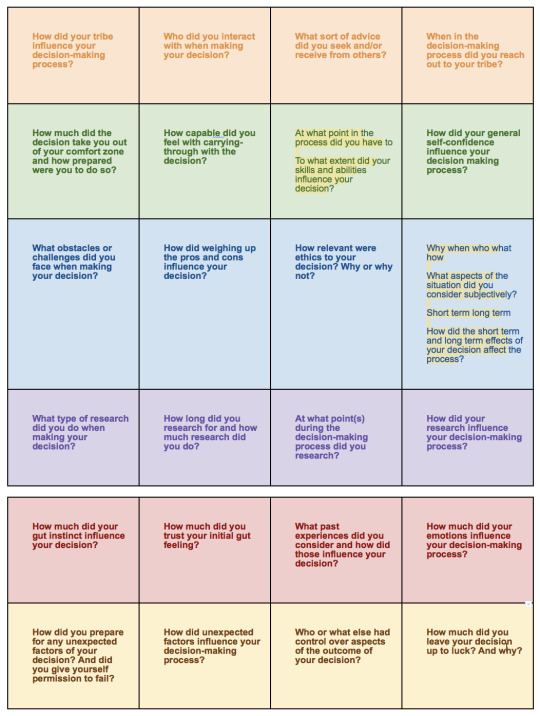
References:
[1] Question Card Iteration - https://docs.google.com/document/d/1slPZBOk2hEwNGfBCBYisIRxIAMwIRnF3VzAYNoB8xao/edit
[2] Love Letter - https://boardgamegeek.com/boardgame/129622/love-letter
[3] Fire of Eidolon - https://boardgamegeek.com/boardgame/190333/fire-eidolon
[4] Initiate.Collaborate - https://www.initiate-collaborate.com
———————————————————————————————————————————
0 notes
Text
Interaction & Play
Mid Sem Break (September 2019)
Week 2 Update:
Wednesday, September 11, we conducted our merged playtest as planned. It was a bit difficult to find playtesters as it was still the mid-semester break, and many students were not at University.
Since Shaun and Anja were joining us for the session, we only needed to find 2 more people. We asked one student from BCT and I asked one of my friends who studies Engineering.
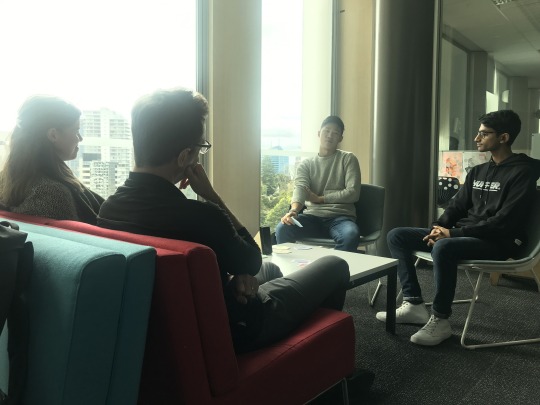
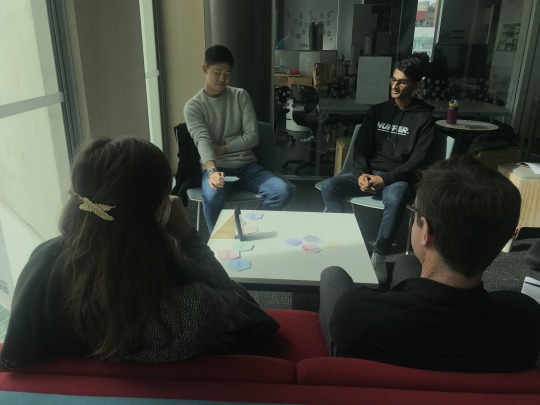



Playtest Feedback and Observations:
The participants weren’t sure where / how to connect the tiles, so we will need to further clarify the instructions. After a couple of cards, more than one category was blocked off because the tiles began to curve around the centre card.
They didn’t realise they were supposed to ask the question to the whole group, not just answer it themselves. We had to pause the playtest halfway to explain this point, so they started went back to the previous card and followed the rules. We noticed that they were very literal as they asked each question to each person, rather than seeing the questions as prompts.
The group forgot about the timer, but were still keeping a good discussion pace.
They spent around 5 minutes on the left side of the follow-up worksheet, and the rest 3 minutes on the reflection side.
They like the aesthetic and look of the cards, as well as the tactility of placing the tiles down.
Overall Feedback and Iteration Idea:

During this week, we had been working on improving the questions as well as the cards. Through our last playtest session, we realised that the ‘rules’ need to be visible on all the cards, instead of having a separate “rule” card that no one reads. This would be much easier for the participants to take actions they would be reading and doing in that same moment.
We used these cards for today’s playtest and to my surprise, it didn’t have much impact on the activity because playtesters were still confused about what to do. The rules were quite clear in my opinon, but some people read and understand differently. We have to cater for everyone and this is what seems difficult at the moment. We will continue working on the card design and have the iteration ready for next playtest.
Reference:
[1] Plan and Feedback for Playtest - https://docs.google.com/document/d/1JMldD_S5XSNCPnc2_1Ipt1obVCciiBXg4E5SdKrt0dE/edit#
———————————————————————————————————————————
0 notes
Text
Interaction & Play
Mid Sem Break (September 2019)
Week 1 Update:
On Thursday 5th September, Carol, Talia and I had a meeting with Shaun and Rebecca to further discuss our progress with the Decision-Making Activity. We had already planned questions and ideas we wanted to ask them beforehand, as we were coming close to the end of the project. [1]
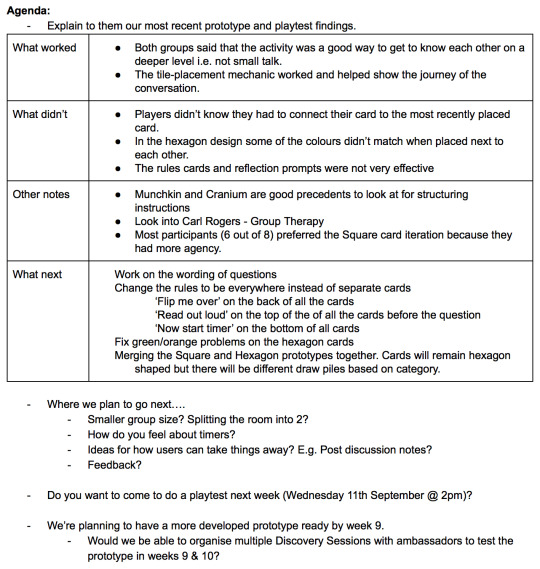
Overall, they were happy with our progress. Shaun agreed to attend our playtest next week and Rebecca asked Anja to join as well. Rebecca also supported us with organising the ‘Discovery’ Sessions with Student Ambassadors, during Week 9 and 10.
Timeline for the rest of the Semester:


We’ve also been working on iterating the Influences Questions, based on the feedback we have received from our previous playtests. Through this, we have also decided to reduce the number of cards/questions to 4 per category. This has allowed for better worded and broad questions that will work with a variety of decisions. We will keep iterating as I still believe that the questions are a little off topic, even though we have tried very hard to fixate them on each Influence.

While Carol worked on designing the front of the cards for our next playtest next week, I designed the back of the cards. We realised that they would need to be “named” as they will be a part of 6 draw piles (one per Influence), not just one. So, as we created the back of the hexagon cards as we did with the squares. The “front” of the cards needed work though. Talia mentioned that the questions were not properly placed on the card and could be laid efficiently. We also added the rules on the top of the card to test out how people respond to that. This should make the overall experience easier because the participants would read from ‘top to down,’ hence reacting to the instructions first. We ensured to make them as easy and concise as possible. And to add another element to the card, we wrote “Share. Discuss. Reflect” at the bottom of the card to indicate them to share their decision with the group, discuss the questions and reflect on their decision-making style.
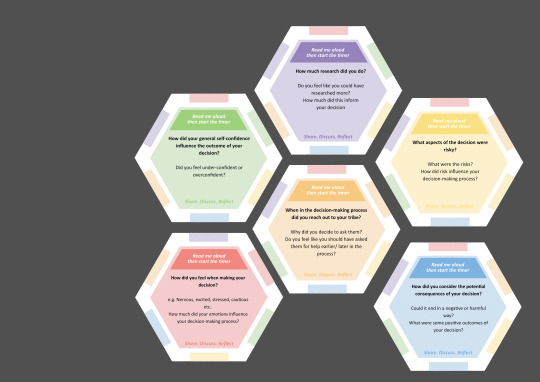
Above: Cards designed by Carol | Below: Cards designed by Vaani

Reference:
[1] Meeting with Wiser - 5th September - https://docs.google.com/document/d/19i7QEO2UelaBg1ZBBI2evqi1OXBeUNnZ6nlTOCum4T0/edit
[2] Question Cards Iteration 2 - https://docs.google.com/document/d/1qqEgl7j8dBJMJxVsVraLexUjTWQnkTN1SJZ-OtJ5YxM/edit
———————————————————————————————————————————
0 notes
Text
Interaction & Play
Teamwork Thursday (29-08-19)
Today, we prepared for the Playtest session with our Hexagon and Square cards. After printing them out, we cut and glue them onto card paper to add some thickness and a card-like feel to it. We had already confirmed a time with Ben to participate in one of the playtests, and also found a few other students to complete the group. We made sure to have a mix of BCT and other AUT students to accurately depict the target audience for Wiser’s Decision-Making Workshop. We also made sure to set up a comfortable and welcoming environment for our playtesters, with couches and a coffee table so they feel open to discussion. We also decided on 4 people per playtest, as it would allow them more time for discussion and it won’t seem intimidating with 8-10 people in a small space. It would be a similar situation to the Decision-Making Workshop in the Wiser space, however, this would be smaller version of the playtest.
Playtest Session 1:

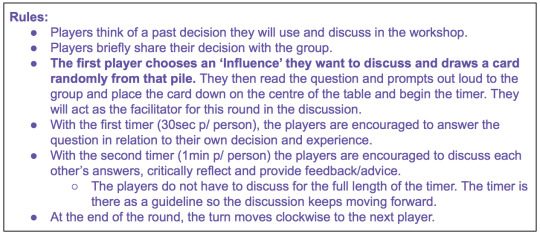
This group talked more about their decision and opinions on the topic, rather than their decision specifically. This created a less in-depth conversation, however the students were comfortable and responded that a four-way discussion works well. They were also making eye contact with each other when talking, and were respectful.
The wording of some of the questions need improvement - for example, “seek” implies that you are looking for advice but you get advice all the time even if you don’t want it. So, in short, the questions need to relate to the Influences more specifically, and not be contradicted.
One of the participants connected the card in the wrong side, so the colours didn’t match. We need to be more specific regarding this aspect of the activity and let people know at the start to join the cards with the available colours so they match correctly. They were also confused about how the cards “work,” and played the activity as they thought it should go, which wasn’t the intended way. The rules at the start confused them, so we need to reword the rules, or simply explain the activity ourselves.
The group also had a range of decisions, which kept the discussion interesting. All members in the group also liked to talk - not sure if it is good for the activity or not, because each person will add in more time to the overall discussion. So, we need a way to use the timer to allow for the discussion to stay on track.
Some questions were confusing and did get them to go off track - not sure again if this is good or bad for the activity, as they are still covering other topics and areas of decision-making. But, they may not have learned much about their decision-making habits as they didn’t fully reflect on their decisions. Although they were self-facilitating, they only reflected by justifying, agreeing and supporting each other’s decisions, which is not fully meeting the criteria of the activity. We need to make it clear at the beginning that their discussion needs to be based more around their chosen past decision.
The participants preferred to choose their own category to discuss about, however they didn’t like the amount of control this had on the overall discussion.
“Fun way to participate in a meaningful conversation.”
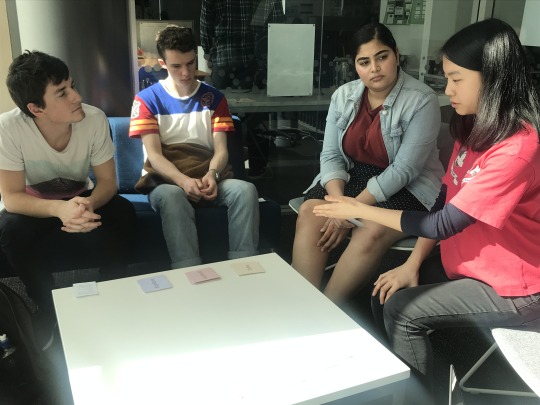

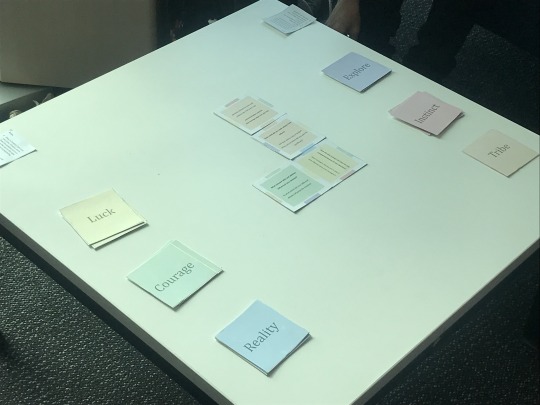
Playtest Session 2:
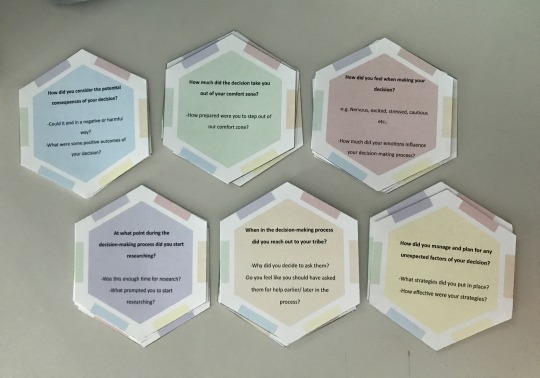

This group talked about their decisions specifically to the questions they were asked. There was a good range of decisions being discussed, for example, a very life-changing one compared to an everyday superficial one. The questions were better understood by this group and they took interest in each other’s decisions and asked follow-up questions. They responded that it was a good way to know people beyond a superficial way. They were talking to each other, rather than to us, like the previous group did - so, it was well self-facilitated. They would move on from the question and keep discussing, rather than dwelling on the questions or the prompts. However, they did feel a little bit of pressure to talk because of us (Carol, Talia, Vaani).
The timer mechanism wasn’t too effective because it was on a screen and wasn’t too obvious. The participants kept talking without needing to stop to check the time, as the discussion was going smoothly. The randomness mechanics were good as it was pushing them out of their comfort zone and giving them a chance to answer questions on the spot (which is usually the truth), instead of pre-thinking what they want to talk about. It felt natural to the activity.
Explaining the categories at the start of the activity worked well, as they understood the idea of the discussion. They also read the rules themselves, however, we think we still need to explain it properly ourselves. This also links to the cards and how the colour-matching aspect works. The “burning” of the cards only happened at the beginning, when the card category was repeated (because the matching colour wasn’t available). But this group passed the cards around so everyone would get a turn to hold it and read it properly, which was great.
The overall experience for this group was interesting, as it was a chance to learn / know about and understand complete strangers. It “humanised” them, as they responded empathetically to the decisions and discussion topics. They also liked placing down the hexagons and creating a pattern, because it was both a visual representation and a progress map, which made them feel creative. The value of this activity for them was hearing about others’ experiences and allowing time to think about decision-making compared to the reflection of past decisions.
Majority of the participants preferred the “square” cards as they liked the idea of choosing their own Influence card.
“Deeper than surface level conversation”
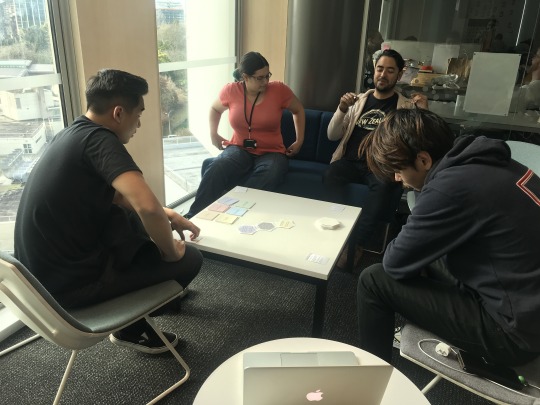
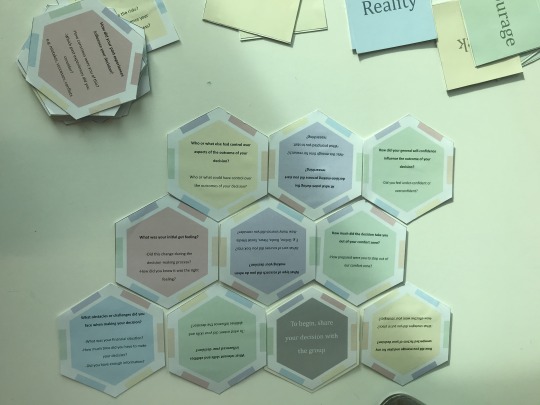
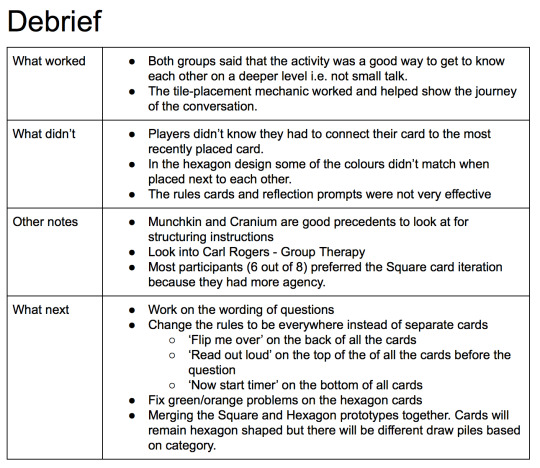
So, after our debrief, we have come to a conclusion to merge the two ideas for our next playtest. This would happen during the mid-semester break. The participants prefer the “hexagon” shapes and the rules of the “square” cards - having 6 draw piles so that players get a sense of agency when they choose their discussion topic (Influence). This would create a more meaningful discussion. I have also noticed through each playtest and iteration, the playtesters are having more discussion and flow. And since the number of participants work well, we plan to keep having 4 people per playtest. In terms of Wiser’s Decision-Making Workshop, we imagine that the students would be divided into two groups, set in different pods, to have their own self-facilitated discussion.
We have a meeting with Shaun and Rebecca next Thursday, so we can plan holding ‘Discovery’ sessions with Student Ambassadors after the mid-semester break, to gather more feedback and data.
Reference:
[1] Rules of Play (Square and Hexagon Playtests) - https://docs.google.com/document/d/1SsbKE1IItmriJlXs-EPaiCoGwBzMjfgl319kVUnkgvg/edit
———————————————————————————————————————————
0 notes
Text
Interaction & Play
Day 7 (26-08-19)
Today in class, we further discussed the Playtest with Ben. He seemed to be enjoying seeing our progress and provided some tips that I don’t think we really considered. Firstly, he mentioned that the dice mechanics along with our Bingo Board will be diminished a little. In our activity, the dice rolling step would be a redundant step, as the Board only has a limited set of actions. So, the players should get an option of choice, where they can choose which topic they want to discuss. He also predicted that the players may still find the board intimidating, in the sense that they have to fill it up completely and spend time talking about all of the Influences. It also doesn’t really give a sense of progression or “journey,” so these aspects needed to be play-tested.
In Studio, we discussed how the discussion would run and started a playtest amongst ourselves. We skimmed through the playtest using a couple of different ways. First, we played with the dice, rolling it on our turn and discussing the question prompt. Then, we put the dice aside, and set up 6 “draw piles” to choose a card from. On our turn, we would pick one card from the Influence we want to discuss and place the card on the board.

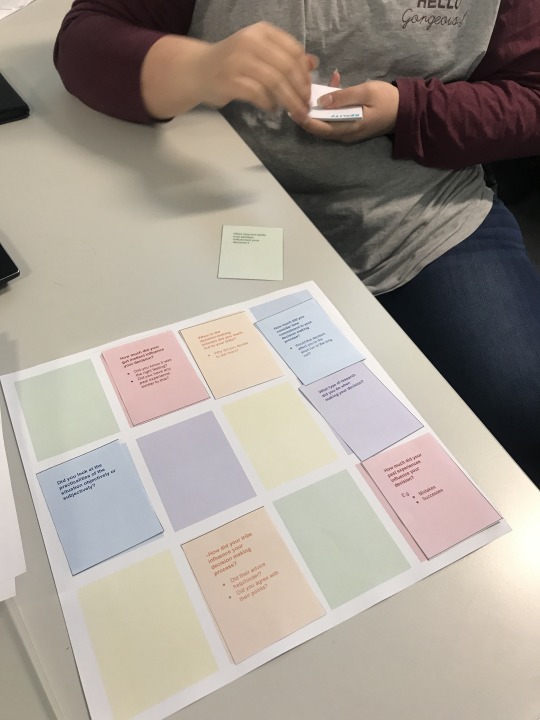
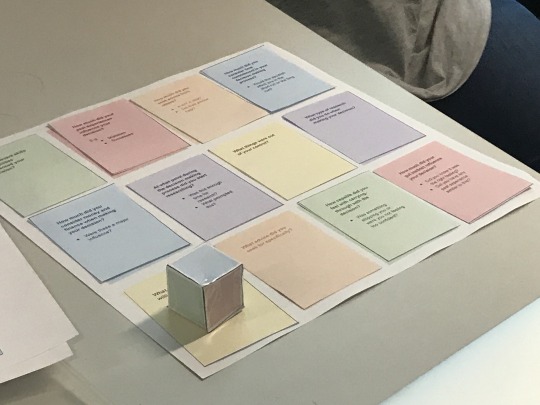
Through these playtests, we realised that Ben’s prediction was somewhat true, because our own experience proved that the Bingo Board wasn’t less intimidating than the cards, and that the Dice was in fact redundant to the activity. Through the board, we didn’t feel a sense of journey, as it was only a visual representation of the discussion questions.
I was a little sad that this wasn’t tested by other students, in order to receive feedback regarding specific aspects of the idea. However, I think it would have wasted their and our time because we have realised our speed-breaker and can now spend time looking at other mechanics to improve the activity.
Again, we started discussing the next iteration through an idea session. Talia and Carol referred to the Fire of Eidolon [1] game that we played last Semester. This game belongs to Carol, and we got together after the Studio V Submission to unwind, relax and play board games. It was one of the board games we played many times, because of it’s progressive and fun game mechanics. It provides the players with some control over their characters and strengths, which also helps with the challenges occurring throughout the game.
So, our next step was influenced by Fire of Eidolon. We decided on designing the cards in a way that would provide the users control over their Influence card and create a sense of journey. Its existing rules gave us an idea of a tile-placement mechanic, which allows players to draw a card from the pile and connect it to an available tile, while creating a modular board in the process.

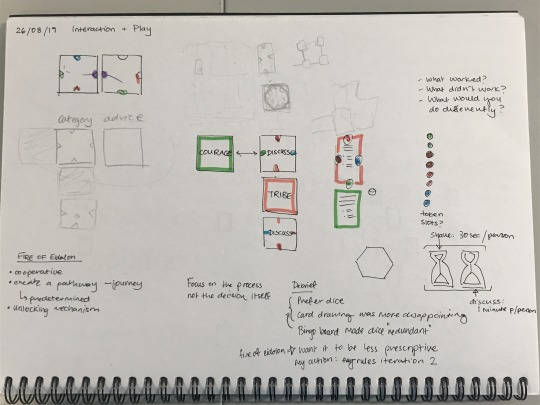
So, we started working on the Rules of Play and Cards for this idea, and prepare for a playtest on Thursday. We decided on having two separate ideas, one playtest would contain square-shaped cards, while the other would include hexagon-shaped cards. These ideas were decided upon to provide us with different game play mechanics relating to each card and understand which idea works better for our concept and outcomes. [2]
The square shape was inspired from the Fire of Eidolon game, which would only have 4 colours around the edge - providing the players 3 available Influences to choose from. On the other hand, the hexagon shape was inspired from the 6 Influences - proving the players 5 available Influences to choose from. However, we also thought of having either 6 different draw piles, or 1 draw pile of the cards, as it would test two different play mechanics, including agency and randomness.
For example, the Square-shaped cards would allow the users to choose from the 6 Influence piles and then connect their chosen option to the first card (as they can only choose between 3 other colours). Whereas, the Hexagon-shaped cards would have 1 pile of all the cards shuffled together, so the next card would be completely dependant on chance, and connect with the first card (as it has all options available).
Carol was again designing the cards, iterating each idea based on our feedback. She followed the same pastel colour scheme, as we all believed it was appropriate for our activity / theme and the target audience.
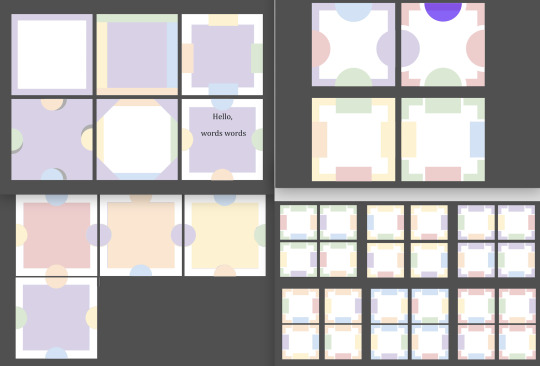
Square Cards iteration - testing colours, visual design and borders

Square Cards iteration - testing card size, structure and visual design
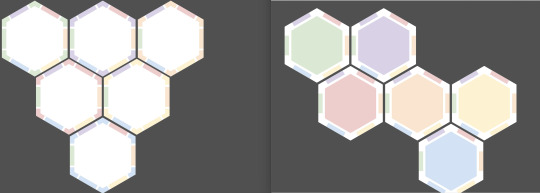
Hexagon Cards Iteration - testing colours, proportion and structure

Final Hexagon Cards - with questions and prompts
Overall, I think today’s class was really constructive. We faced a problem and we found solutions that work in reasonable ways. And we are planning to already continue with our next iteration. I think we three work very well as a team. Although we do have some arguments regarding ideas and criticism, we tend to move forward and focus on the project to find new solutions, game mechanics and better-suited rules of play.
Reference:
[1] Fire of Eidolon - https://boardgamegeek.com/boardgame/190333/fire-eidolon
[2] Rules of Play (Square and Hexagon Playtests) - https://docs.google.com/document/d/1SsbKE1IItmriJlXs-EPaiCoGwBzMjfgl319kVUnkgvg/edit
———————————————————————————————————————————
0 notes
Text
Interaction & Play
Teamwork Thursday (22-08-19)
Coming towards the end of Week 6, I truly can’t believe how far we’ve come with this project. I am really happy and proud to be a part of this group, and by how quickly we are progressing with our idea. Our playtest sessions over the past few weeks have been extremely useful with feedback for improvement. We have designed iterations of the original idea, starting with “questions,” then to “dice,” “spinner,” “cards,” and now landing on a “game board.” This iteration process has allowed me to learn the different play mechanics relating to each idea, and also gain knowledge about the overall design process through user testing and feedback. One thing I’ve benefited from would be the learning obtained through our players’ decisions and hearing them reflect in different ways, as well as reacting empathetically in group situations.
Today, Carol, Talia and I discussed our last playtest and changes for our next iteration, planned to take place on Monday. Looking through our debrief, we realised that there were a few things we could really work on, to improve the discussion aspect of the activity. For example, designing the board to look like an actual “game board,” to provide a sense of journey, and adding prompts / rules to the activity to provide “discussion” time as well as having a system so the participants answer each category at least once.
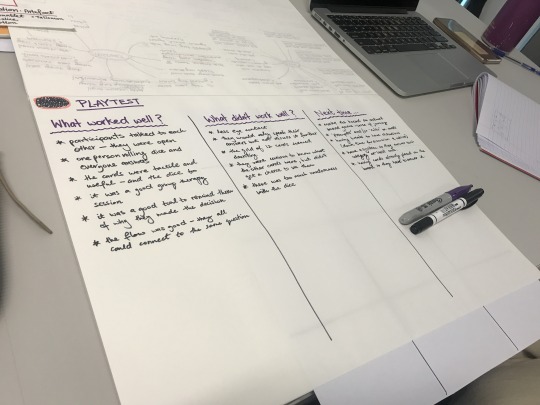

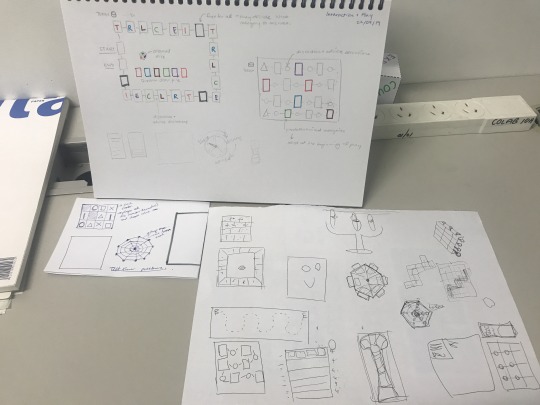
This debrief turned more into an idea session, where we all spent 10 minutes individually to come up with ideas for the board. It was surprising to see the different ideas we had about one aspect of the activity, and ow differently it would work. Through our discussion, we landed on having a “bingo board” - one of my ideas, which would provide the players with a board containing only 2 card spaces per category, while also limiting the randomness and chance mechanics. The 6 - sided dice will still be in play to add playfulness and a sense of agency. Upon further discussion, we realised that the board had been inspired from games such as Cranium [3] and The Game of Life [4], which allowed us to look at their game mechanics to create the rules for our activity.
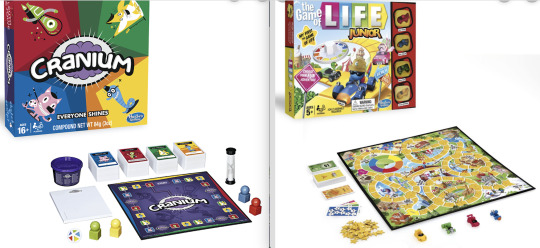
So, over the weekend, we worked on the Question Cards, Play Rules for the activity [1], the Bingo Board, and the Dice. Carol mainly worked on the visual design, iterating through our feedback.

First Iteration - Exploring Board / Card Shapes, Style and Colours
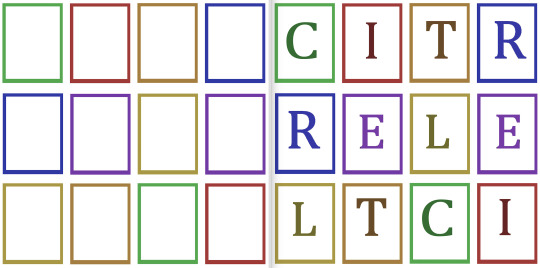
Second Iteration - Finalising the Rectangular Card Shape

Dice Iterations - Colours / No Fill / Outline
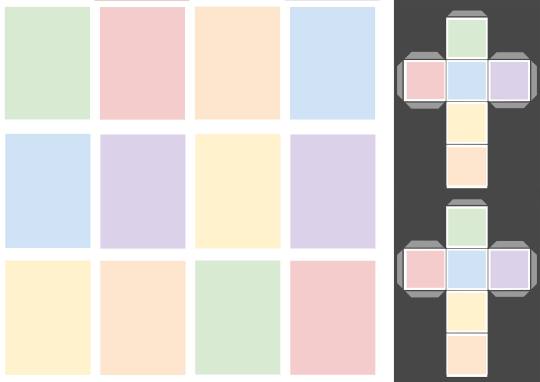
Final Cards and Dice - a pastel colour scheme
Talia also created an Excel Timesheet for our group timeline and progress, and marked important dates for the rest of the Semester [2]. This allowed us to stay on track and refer back to for tasks, since we have slowly stopped using our Trello Board. We set up a meeting time with Rebecca and Shaun during the first week of the mid-semester break - 5th September, to further discuss the progress of our project.

References:
[1] Rules of Play for Bingo Board Playtest - https://docs.google.com/document/d/1-gXuZQBEpdlmfyxysL80eEjISdB81wgSP5go5rIqQyg/edit?fbclid=IwAR1VdMD-iIYMUc788UlKR1iUt_NZe-xNGGeMVsfVccE0icyc_cnFytkDXSI
[2] Excel Timeline - https://docs.google.com/spreadsheets/d/1OF9p3L2IV8wjUCjx2N3Pm3N72b77rZrhrsvK_w1AUIA/edit#gid=0
[3] Cranium - https://boardgamegeek.com/boardgame/891/cranium
[4] The Game of Life - https://boardgamegeek.com/boardgame/2921/game-of-life
———————————————————————————————————————————
0 notes
Text
Interaction & Play
Day 6 (19-08-19)
Today was our second Presentation day. All the teams in our class showcased their videos for us to provide them with feedback. Our group seemed to be on track and Ben guided us with some great feedback and References to help develop our project idea.
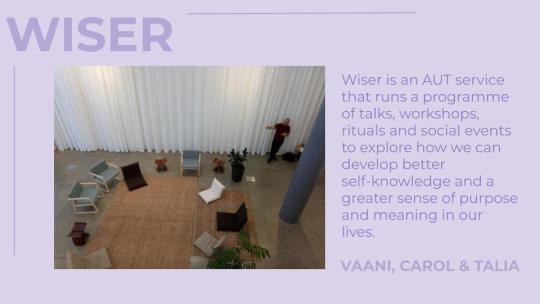
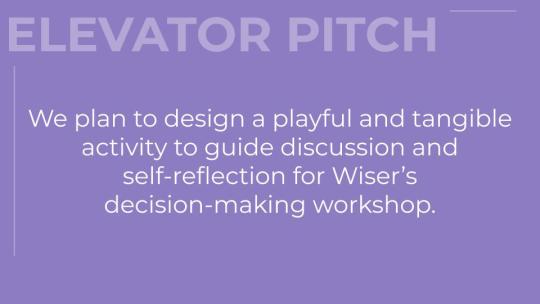
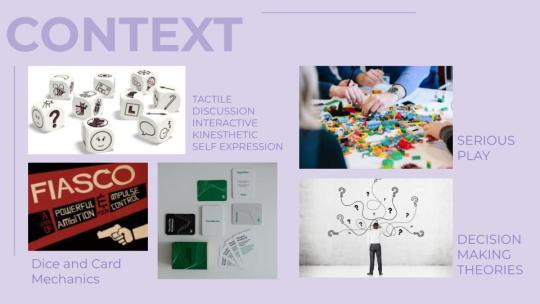
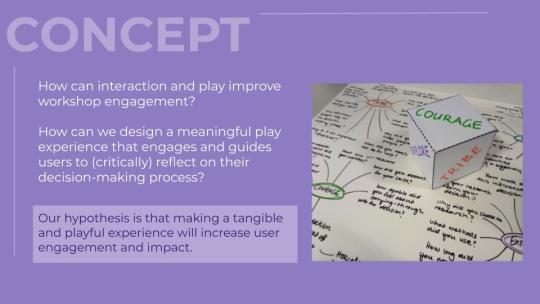
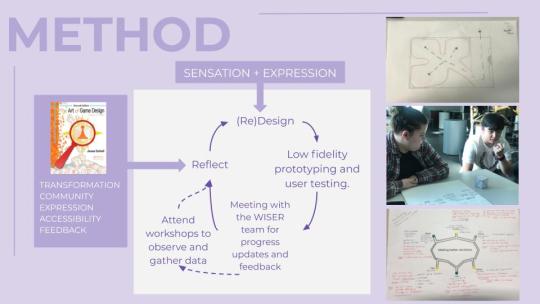


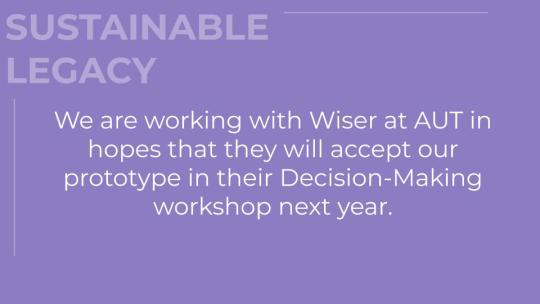
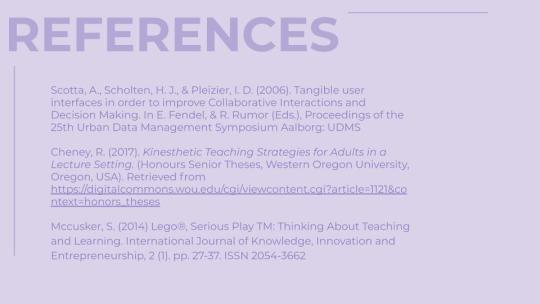
Feedback from Ben:
Firstly: Outstanding project so far! Valid concept communicated clearly and concisely. There is clear evidence that you have already learned from sound and varied game and play design frameworks that will inform your practice for the rest of your life. Now focus on the few remaining gaps and the synthesis of some of these methods for your prototyping and testing phase.
Cite the theories that validate your analysis of value and qualities of ‘chance’ (“unpredictable”) mechanics. Start with Caillois Alea - p303 [3] but I would also continue to look at p181 around Uncertainty and Risk as essentially your project is about using the value of uncertainty but then managing the risk of the discussion not leading to all (or as many as is necessary) end points (“factors”).
What are the next steps with mechanics? Firstly, accept that you won’t solve all of the workshop’s issues. That’s too large a scope for a 15pt Level 7 paper. There are essentially two design problems in this project and you should design the most elegant solution for them as possible. The first is random generation mechanic. Starting with cards sounds like an easy win from many perspectives. The second, is the mechanic that leads the conversation back to the end points, the content, the factors. This should be the focus for the next next week. Please come with a working prototype that attempts to address the risk of “missed content” next week so we can play test in class. Don’t re-invent the wheel. Use pre existing mechanics and mutate them as you go.
Ben’s thoughts and provision of direction helped with discussing our next playtest idea. We were creating a sense of meaningful conversation through the questions, however we needed to find a way to control the discussion around the factors. We needed to find a way for the participants to reach the end, to arrive at an outcome, or have a realisation regarding their decision. This was a bit difficult to solve without playtesting and user feedback, so back in Studio, we conducted the playtest session with our new “question cards.” Since I had an important meeting to attend, Talia and Carol organised and facilitated the playtest.
They decided to add a little change in the play mechanics, by adding a game board to control the discussion and questions within the group. Seeing the set of cards was apparently intimidating for some people, so having a modular board allowed for an aspect of play that seemed more natural and familiar. The participants would pick up a card from one category (during their turn) and place the card onto the board when they finished reading the question. That participant would also act as a facilitator for the round and ask the question to the whole group, instead of just answering it themselves. The board also introduces another design concept to the activity, as it provides the players a “visual representation” of their “discussion journey.” This allows the overall activity to stay more memorable for the participants, as they can refer back to the questions they chose and discussed together.

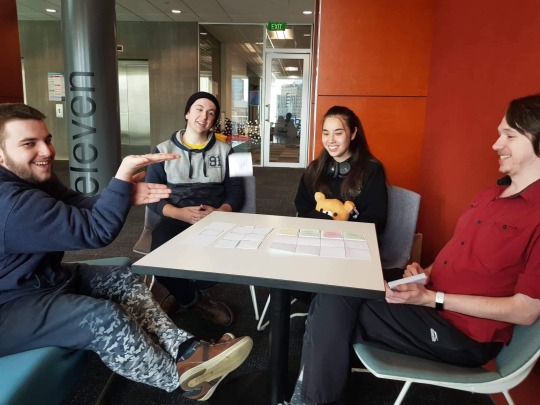
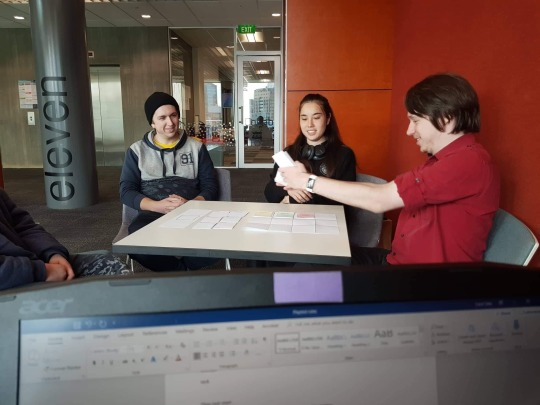
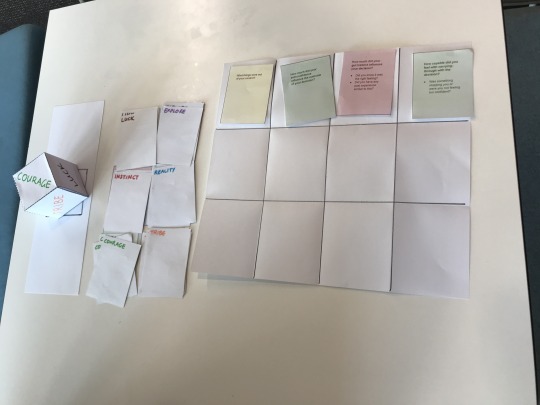
Here is the Playtest Debrief:
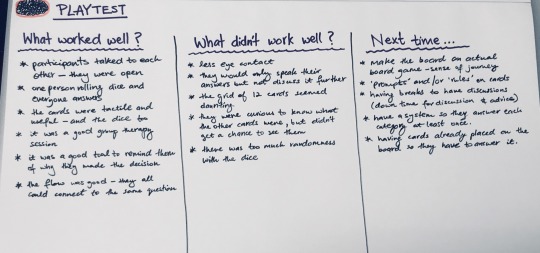
We also emailed Rebecca and Shaun, to decide on a time to meet sometime next week and plan for playtests after the mid-semester break. I think the playtest we conducted today worked in our favour, as we now feel more confident in carrying through with the idea. This will also provide evidence to the Wiser Team that we are making progress with the idea, and are planning to iterate.
Reference:
[1] Video Presentation Slides - https://docs.google.com/presentation/d/1ev8pDrqSV32C-iqCMPY8bMkAuDvI2of1PCn-K6gLBsg/edit#slide=id.g5f8d806e65_0_165
[2] Video Presentation Script - https://docs.google.com/document/d/18UeVYAkP2HAzraMDoQgKTy3gmP0pLgb2Kbc6-1i47UA/edit
[3] Salen, K., Zinnerman, E. (2004). Rules of Game Play. Chapter 15: Games as Systems of Uncertainty (pp. 173-189) Cambridge, Massachusetts: MIT Press.
Retrieved from https://gamifique.files.wordpress.com/2011/11/1-rules-of-play-game-design-fundamentals.pdf
———————————————————————————————————————————
0 notes
Text
Interaction & Play
Teamwork Thursday (15-08-19)
Carol, Talia and I had a meeting with Shaun and Rebecca yesterday to discuss our progress with the activity. We explained our playtests firstly, and then gave them an overview of what went well and which aspects we need to improve on. We also asked them questions regarding aspects we needed to clarify.
Here are the debrief notes:
Had meeting with wiser - shaun and Rebecca yesterday
Debrief:
Went well
they’re happy with our progress
Like the idea
Answered important questions,
Today, we had planned to work on the Group Slides and also create the video for our Presentation on Monday. We were all tasked to complete certain slides in the presentation, so we were more prepared for the video. However, there were still some changes we needed to make to previous slides, including, Concept, Context and Method.
After this, we moved to the small office in the Year 1 Studio to record ourselves for the video. This was quite fun actually. I have never liked my voice on recording and mostly messed up my part of the speech, but overall, we laughed and it felt nice.
As I had to leave early for a meeting, Carol and Talia worked on producing the video using Adobe Premiere Pro. Although the video wasn’t visually appealing, it was a basic presentation of our idea and research, as well as our progress.
We also discussed our next steps for the Playtest. Through our previous ones, we realised that there needs to be more structure to the overall activity, which is why we planned to use cards for the questions in our next playtest. The cards provide mechanics that the spinner was lacking. It will also provide a sense of “game-like” exercise and agency for the participants. So, we’ll work on the cards through Google Docs, where we can all manage the questions and design the cards.
Reference:
[1] https://drive.google.com/file/d/1LOt_jpvqOtLE6RlQ0PGALSUygBD2KCIR/view
———————————————————————————————————————————
0 notes
Text
Interaction & Play
Day 5 (12-08-19)
Today was another useful session. As there weren’t many groups in class today, Ben was able to spend a good amount of time with our group and provide feedback, as well as a direction. He was great help today - prompting us to think about other methods of conducting the activity, and look into various mechanics (cards, dice, spinner, etc.). He also tried out our first playtest and provided feedback, which we used to help us iterate the idea.
Ben’s Thoughts:
Is it important to answer all the questions?
Should the questions explain the categories?
Is there a way to prompt the users to go to other questions? (another mechanic that leads them to other parts of the Influence, so they get to the important / juicy questions)
How can we create a system to push the conversation along?
How can we explain the Influences without Shaun’s example? (numbered cards that explain the decision-making process and the 6 influences in an coherent manner.)
Look at ‘flavour text,’ ‘prompts,’ ‘tutorial cards.’
Next, we decided on the questions to ask Rebecca and Shaun for our meeting on Wednesday. We were a little confused about how the activity would plan out, so we needed a better understanding of the research behind the workshop. I think these question are enough for a start, because I’m pretty sure we would ask them more about the topic as we converse.
So, we decided to ask them about:
What was the research you based the decision-making workshop off?
Can you please explain the frameworks of the Influences worksheet?
Is the worksheet what you expect people to ‘use’ to help them make decisions?
What made you decide on everyone having their own personal future decision, instead of one decision for everyone to work on?
Why did you choose the six ‘words’ for the Influences? Why THOSE words in particular?
What is the purpose of the card ice breaker exercise, does it have to be this?
Why did you choose others to introduce us, not ourselves?
What is the maximum time you could extend the workshop to?
Could we run a more developed playtest with the students with Wiser’s help?
We then continued the conversation about the playtest. Regarding the “questions” for each of the six influences, Talia had an idea to have 3 separate dice, which would gradually increase the ‘level of difficulty’ of the questions. However, thinking about that brought up a few issues regarding the creation of the dice, as well as the progression of the activity. So, we thought about adding new mechanics into the activity, as Ben suggested. To create a decent flow and engagement within the participants, we decided to divide the process into three parts - ‘Before’ and ‘After’ questions and ‘Group’ discussion. This way, there will be time for reflection and discussion for each person.

In Studio, we developed the activity and worked on the questions for the Influences. While doing this, Carol brought up an issue about the “Before” questions being somewhat similar to “After” questions, just with a change of the tense. I totally agreed with her point, because we don’t want to repeat the aspects of the activity. It would get boring and repetitive. Instead, we want the users to understand their decision making process and know what actions they will take in the future.
So, we thought that playtesting the first idea with a group of people could present us with useful feedback and solutions to our concept. We gathered a few students from around Studio and ran the playtest like Talia did on Monday. I think this was very useful because we did learn from the users and understood their feedback about what could be improved. It was also useful to observe the participants’ actions throughout the playtest as it proved how well the activity ran.
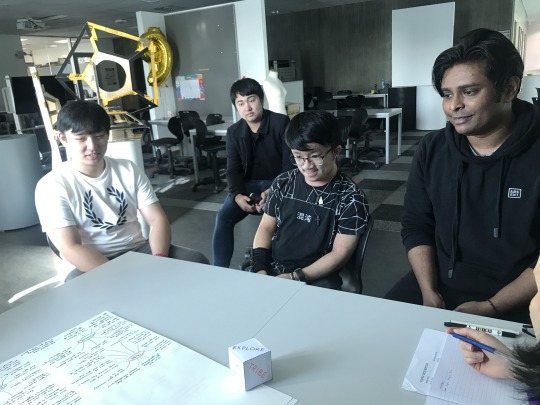


Observations of the Playtest:
Need a structure or some sort of a system to decide how the users participate, and who starts / goes next.
Need the participants to share their past decision with the group to get the context behind their answers.
Need better questions that share a common ground with the Influence - some questions are not relevant to the participant’s decision.
Need a way of avoiding repeated questions - keep a track record.
Need a way to encourage discussion between the participants, not move on after answering the single question - depends on ice breakers, different personalities.
Need the users to facilitate the activity / discussion, not just talk to us.
Participant’s Feedback:
Having a ‘Dice’ is a good idea - makes you think about the decision making influences, a good starting point, however it does get boring after a while.
Should give participants enough time to think of a relevant decision, not something small.
Questions are interesting - need rephrasing to link to each influence, but it is implied that they can’t change the question if they land on it twice (how can we change that?).
The Influences are straightforward - questions need to reflect / communicate the meaning of it.
I believe that we are heading down the right track. We have a few ideas for iteration, which we will work on during our Thursday meeting. The playtests have been very useful for our progress, and we will continue to develop the idea to meet the brief.
To Do by next meeting:
Plan for the next Playtest - better facilitation and organisation, write questions on cards, reword questions to relate to each Influence, ‘sentence starter’ cards for “After” questions, introduce a timer for certain questions.
Work on the Presentation Slides and prepare to video.
Look at implied rules of “Cards” and “Dice” mechanics.
———————————————————————————————————————————
0 notes
Text
Interaction & Play
Teamwork Thursday (08-08-19)
Today, Carol, Talia and I had our team meeting as usual. We firstly discussed and shared what we had researched over the week. As discussed on Monday, we were to research into Serious Play, a concept that Ben introduced to us in class. And we believed that it would allow us to think more about the ‘play’ factor in our Decision Making Workshop project.
Here is a summary of our research:

I think that sharing our research information and outcomes with each other is really beneficial for the group because we will be more informed about the theme and our project. We all looked at different aspects of the same research topic, and I think that demonstrates that we are unable to research everything, which is why sharing a quick analysis of our research keeps us updated. And through this, we will begin to understand the important and recurring aspects of the theme.
In terms of the Project, we realised that we gained very important knowledge from our research, but we need to incorporate that into the project to understand what we are trying to achieve. And to be honest, today’s session was really useful because we believe that we are headed in the right direction.
During our discussion, I expressed the idea of ‘Fear’ being one of the influences we consider for our activity. As my Studio project last semester was based on the concept of how our Fear affects our decisions, I thought it would be relevant in this scenario. I explained the methodologies of my project, and read out a couple of the cards. The most important aspect, in my opinion, was the questions at the bottom of each card, which allowed the reader to reflect on their fears, along with the information they were provided. And I think asking different, reflective questions will give the users an opportunity to express their thoughts properly.
I think Carola and Talia liked the idea of questions. We started with the Decision Making influences worksheet and expanded on the 6 Influences that were provided: Explore, Tribe, Courage, Luck, Reality, Instinct. For each of these factors, we thought of a few questions that would spark critical and reflective thinking, as well as discussion. The questions were varied and responded to each influence separately.

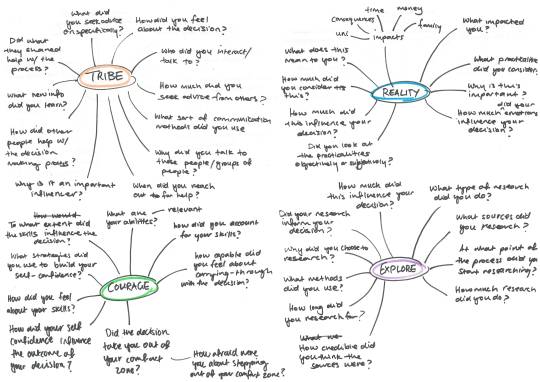

After we formed some questions, we started to think more about ways in which we can make this activity ‘playful.’ Talia and I remembered talking to Ben about the ‘Fiasco’ Game on Monday. And that gave us a starting point - using a dice to democratise the decision making process. Although we don’t want to democratise the process, or start a role-playing session, we thought that using a dice as a medium would give us some understanding of how the activity could run. On Monday, Ben talked about how the dice somewhat takes control away from the participants because it is dependant on ‘Luck.’ So, we thought it could work with the participants, as they wouldn’t have control over the questions, which would allow them to reflect on what they roll. As it also wouldn’t give them time to prepare their answer, they can talk about what comes to their mind immediately, which is often true.
So, Carol printed of some templates of a dice, and we started to design the activity to conduct a quick playtest on ourselves. As I had to leave early, Carol and Talia did a playtest with one of our classmates. While the participant rolled the dice, Talia acted as a spinner to determine which question would be asked. She rolled her finger around the questions on the paper and the user said ‘stop’ to land on a question.
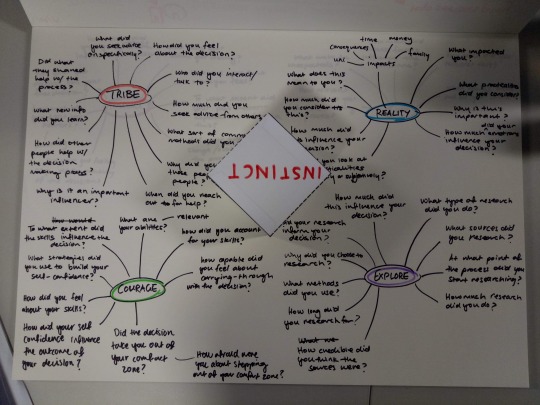
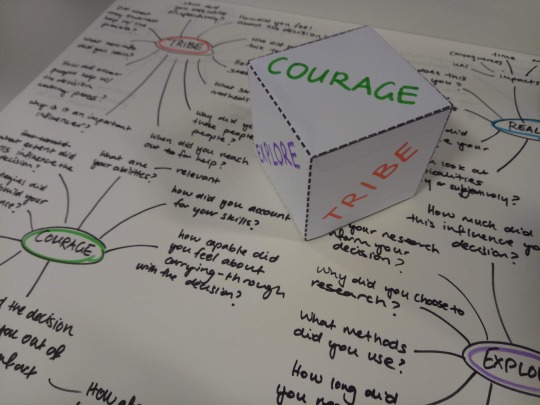
The participant commented that this activity was “interesting” as it gave them “a moment to self-reflect and think about what influenced recent changes" in their life. They liked the dice aspect of the activity as it was fun, and unpredictable. They stated that the randomness was enjoyable and liked the feeling of wanting to get a new question every time they rolled the dice.
I think this was a good start and we’re happy with the direction we’re going in. We really feel like we can explore the project and understand the themes better.
For Monday:
Create the dice for playtest in class
Research into dice mechanics in a game, e.g. Yahtzee
Link to the group Trello Board: https://trello.com/b/vSXRRypO/interaction-and-play
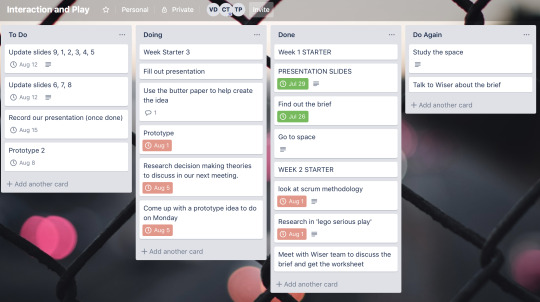
———————————————————————————————————————————
0 notes